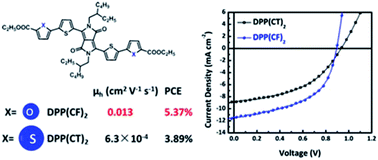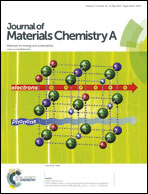A diketopyrrolopyrrole molecule end-capped with a furan-2-carboxylate moiety: the planarity of molecular geometry and photovoltaic properties
Abstract
We designed and synthesized a diketopyrrolopyrrole (DPP) molecule with a fully-planar molecular geometry, 3,6-bis{5-[(ethylfuran-2-carboxylate)-2-yl]thiophene-2-yl}-2,5-bis(2-ethylhexyl)pyrrolo[3,4-c]pyrrole-1,4-dione (DPP(CF)2), for solution-processable organic solar cells (OSCs). It is theoretically calculated that the dihedral angles between the two furan-2-carboxylate end-groups and the DPP core are both only 0.56°. Due to this negligible steric distortion, the molecular conformation of DPP(CF)2 can be considered fully coplanar, leading to a higher crystallinity for the DPP(CF)2 film. As a result, the hole mobility of DPP(CF)2 is one order of magnitude higher than that of the DPP derivative with thiophene-2-carboxylate as the end-group (DPP(CT)2). DPP(CF)2 exhibits both a low optical band gap (Eg) of 1.60 eV and a low-lying highest occupied molecular orbital (HOMO) energy level of −5.33 eV, implying that DPP(CF)2 is a promising electron donor for OSCs. OSCs with DPP(CF)2 or DPP(CT)2 as the electron donor and [6,6]-phenyl-C71-butyric acid methyl ester (PC71BM) as the electron acceptor were fabricated. It is found that the DPP(CF)2-based devices exhibit much better photovoltaic performance than the DPP(CT)2-based devices, with the highest power conversion efficiency of 5.37% and a short-circuit current density of 11.4 mA cm−2. This phenomenon can be ascribed to the superior charge-transporting ability of DPP(CF)2 due to its fully-planar molecular geometry.


 Please wait while we load your content...
Please wait while we load your content...